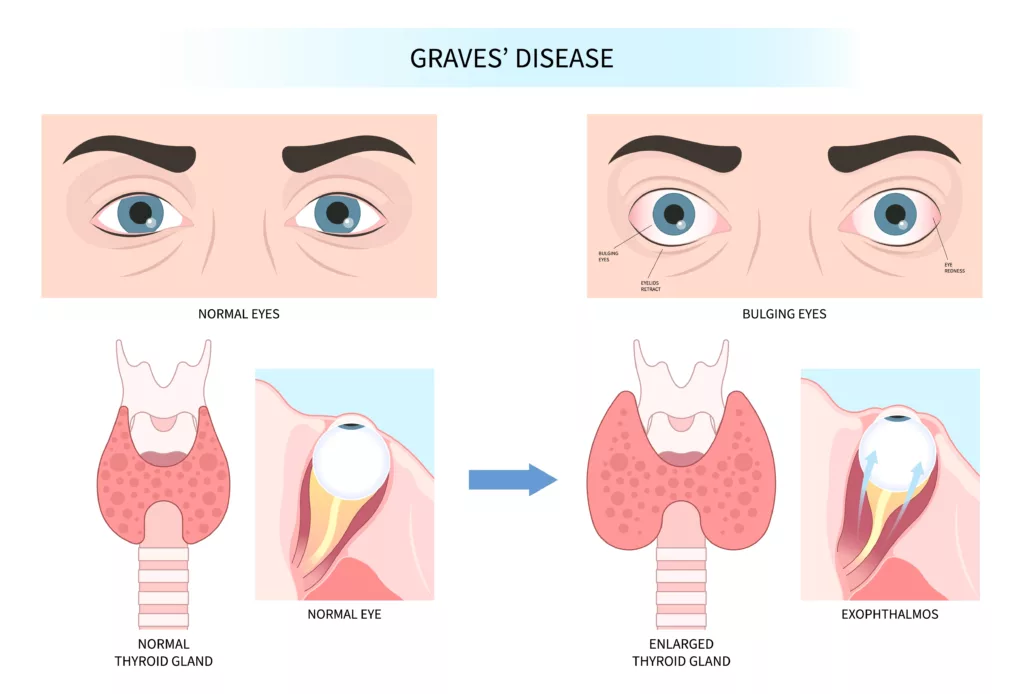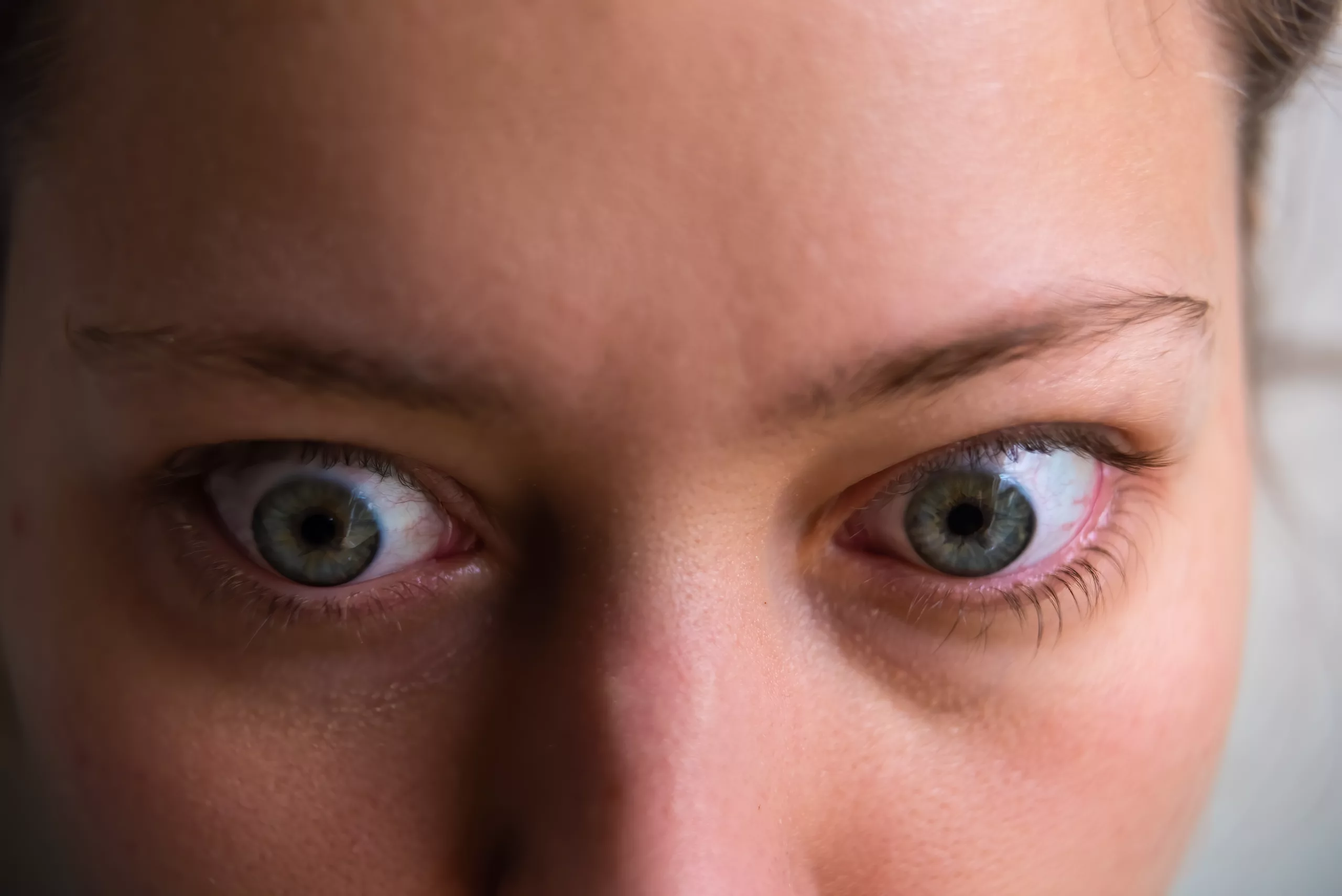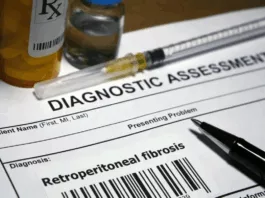Graves’ Eye Disease, also known as Graves’ ophthalmopathy or thyroid eye disease (TED), is an autoimmune disorder characterized by inflammation and swelling of the eye muscles and connective tissue behind the eyes, causing the eyes to bulge forward (proptosis). This condition most commonly occurs in individuals with Graves’ disease, a form of hyperthyroidism, but can also present in other thyroid dysfunctions. In addition to eye bulging, symptoms may include redness, irritation, dryness, sensitivity to light, and, in some cases, double vision.
Though many cases of Graves’ ophthalmopathy are mild and may resolve independently, severe cases can lead to restricted eye movement and, rarely, pressure on the optic nerve, which can threaten vision. Smoking and thyroid dysfunction are significant risk factors that may exacerbate the condition. Treatment options vary based on severity and may range from lubricating eye drops to corticosteroids for inflammation and, in advanced cases, orbital decompression surgery to relieve pressure on the eyes and preserve vision.1 Pillar, A.J. and Richa, D.C. (2014) Treatment options for thyroid eye disease – current treatment options in neurology, SpringerLink. Retrieved 27 November 2023 https://link.springer.com/article/10.1007/s11940-014-0303-8
Pathophysiology of Graves Eye Disease
This disease occurs in two stages: an active inflammatory stage and a stable phase. The inflammatory phase is the first phase characterized by inflammation of eye tissues and persists for months to three years. Treatment during the inflammatory phase is based on anti-inflammatory medications that ease symptoms and prevent further eye abnormalities.
The stable phase follows the active phase and starts after the inflammation diminishes. This is an inactive or chronic phase whereby swelling subsides, but changes in vision and the appearance of the eye persists. The stable phase is also termed the fibrotic phase due to eye scarring that may lead to permanent vision changes. Graves eye disease is a self-limiting disorder that heals after 2 to 5 years without any treatment.2 Hutchings, K.R. et al. (2023) Graves eye disease: Clinical and radiological diagnosis, MDPI. Retrieved 27 November 2023 https://www.mdpi.com/2227-9059/11/2/312

Graves Eye Disease Symptoms
The symptoms of this disease are variable. Symptoms may appear at one time and disappear at other times. Some of the common symptoms that appear in individuals with Graves eye disease are:
- Dry eyes: In Graves’ eye disease, the eyes are unprotected due to bulging forward and retraction of the eyelids. Dust and dirt cause the eyes to become dry.
- Proptosis: Eye muscles swell and propel the eyes outward in individuals with Graves eye disease. The bulging eyes appear as a stare.
- Eyelid retraction: When the eyes protrude, the eyelids pull back, exposing the white part of the eyes.
- Double vision: Swelling of eye muscles puts pressure on the eye and may lead to double vision. In severe cases, muscle swelling can harm the optic nerve, resulting in loss of vision.
- A problem in closing eyes
- Irritation in eyes due to grittiness
- Pain behind the eye during eye movement
- Puffy eyelids
Graves Eye Disease Cause
The exact cause of this disease is unknown, but it commonly occurs in association with a hyperactive thyroid gland. Graves disease (hyperthyroidism) is an autoimmune disease that occurs when the body’s immune cells attack the thyroid gland and result in the oversecretion of thyroid hormone. The thyroid hormone regulates body metabolism, temperature, and heart rate. Overproduction of these hormones abnormally accelerates the body’s processes.
Moreover, the immune system might target the eye muscles and tissue, leading to their scarring and swelling. This condition causes the most predominant eye symptoms, like bulging and swelling. However, researchers are not very sure about the cause of Graves’ eye disease. Some suggest some genes are responsible for causing the disease when factors like viruses activate them.
Who is at Risk?
Although the exact cause is unknown, multiple risk factors contribute to this disease. Individuals with hyperthyroidism are at a higher risk of developing eye problems. Every 1 out of 3 people with Graves disease has a chance of developing thyroid eye disease, particularly women in their 40s. Smoking is another crucial risk factor for developing the disease.3Perros, P., Neoh, C. and Dickinson, J. (2009) Thyroid eye disease, The BMJ. Retrieved 27 November 2023 https://www.bmj.com/content/338/bmj.b560.long Also, individuals affected by an autoimmune disease or those with a family history are more likely to get the disease. Additionally, research suggests selenium deficiency to be an independent risk factor in developing Graves eye disease.
Graves Eye Disease Diagnosis
The primary diagnosis of this disease is based on a physical examination of the eyes and thyroid gland. If you have been previously diagnosed with Graves disease, only an eye exam is enough to tell that you have Graves eye disease. However, lab tests and imaging techniques can be recommended for differential diagnosis to rule out other conditions.
Physical Examination
Your physician might begin with an eye exam and look for the following things:
- Degree of vision
- Visual field
- Optic nerve compression
- Eye pressure measurements
- Eyelid retraction measurements4 BARTLEY M.D., G.B. et al. (2014) Diagnostic criteria for graves’ ophthalmopathy, American Journal of Ophthalmology. Retrieved 27 November 2023 https://www.sciencedirect.com/science/article/abs/pii/S0002939414727874
- Color vision
- They might use an instrument called an exophthalmometer to check the extent of bulging in the eyes.
The above symptoms indicate that you might have Graves eye disease.
Laboratory Tests
After initial physical findings that indicate thyroid eye disease, your physician will order a blood test to determine levels of the following to confirm the diagnosis:
- Thyroid Stimulating Hormone (TSH)
- Triiodothyronine (T3)
- Thyroxine (T4)
- Anti-thyroid peroxidase antibody (anti-TPO)
- Thyroid-stimulating immunoglobulin (TSI)
- Thyroid-stimulating hormone receptor antibody (TRAb)
Imaging Tests
Imaging tests are recommended to visualize enlarged eye muscles, compressed optic nerves, an enlarged thyroid gland, and inflamed tissues. The following tests are used to confirm thyroid eye disease:
- Thyroid ultrasound provides images of the enlarged gland or nodules.
- A radioactive iodine uptake test and an X-ray determine the amount of iodine accumulated in the thyroid gland. This indicates thyroid function.
- CT scans and MRIs provide the most accurate details of the thyroid gland. These imaging tests also show the extent and severity of eye symptoms.
25% of individuals with Graves disease have a chance of developing Graves eye disease.
Graves Eye Disease Treatment
Treatment of Gaves’ eye disease is mainly palliative because the exact cause is unknown. The therapy aims to prevent the advancement of illness, improve appearance, and avoid functional eye disorders. Various natural remedies and medications help treat mild forms of the disease. However, more severe forms of illness require surgery and sometimes radiotherapy.
Care Strategies and Lifestyle Modifications:
Simple strategies and lifestyle changes help relieve the symptoms of this disease. You may adopt some easy tips to reduce eye swelling, dryness, and double vision. Here are some easy recommendations you can follow at home:
- Put on sunglasses when you go out in the sun
- Apply a cool compress on the eyes to relieve irritation
- Raise your head slightly above your body level while sleeping. This will aid in reducing the swelling of the eyes.
- Tap your retracted eyelids to shut them entirely before sleep to prevent dry eyes.
- Use glasses with special prism lenses to correct double vision.
- Stop smoking
Medications:
There are many over-the-counter OTC medicines for Graves eye disease on the market. Also, your healthcare provider may prescribe any medication to relieve inflammation and worsen symptoms. Following are some commonly recommended medications.
OTC Medications
You can use OTC eye drops, also known as artificial tears, to lubricate dry and dusty eyes. Moreover, selenium supplements also help improve the symptoms of eye disease if you have a deficiency of this mineral.5 Lanzolla, G., Marinò, M. and Marcocci, C. (2020) Selenium in the treatment of Graves hyperthyroidism and eye disease, Frontiers. Retrieved 27 November 2023 https://www.frontiersin.org/articles/10.3389/fendo.2020.608428/full
Prescription Medications
Your healthcare provider might recommend medicines, such as prednisone and rituximab, to reduce swelling around the eyes. Also, there is a new medicine, teprotumumab, for individuals with Graves eye disease.6 Ugradar, S. et al. (2021) Teprotumumab for the treatment of chronic thyroid eye disease, Nature News. Retrieved 27 November 2023 https://www.nature.com/articles/s41433-021-01593-z If you experience any side effects from these medications, consult your physician for appropriate advice.
Surgery:
Surgery is usually recommended for individuals with irreversible double vision. Surgical treatment involves readjusting the position of the eyelids and eyes to improve their appearance. Surgery is ordered for severe forms of eye disease; otherwise, it is managed with medications.
Orbital Decompression Surgery
Your healthcare provider would go for orbital decompression surgery if you have a double vision problem. The surgery involves enlarging the eye socket to relieve the optic nerve pressure and remove excess tissue.7Boboridis, K.G. and Bunce, C. (2011) Surgical orbital decompression for thyroid eye disease – boboridis, KG – 2011: Cochrane Library, Cochrane Database of Systematic Reviews. Retrieved 27 November 2023 https://www.cochranelibrary.com/cdsr/doi/10.1002/14651858.CD007630.pub2/abstract This surgery helps the bulging eyes get back to their original position. If your physician recommends multiple eye surgeries, orbital decompression surgery is done first.
Eyelid Surgery
Retraction of eyelids makes it difficult for the upper and lower lids to move down or up, respectively. Eyelid retraction can result in corneal damage due to excessive environmental exposure. Eyelid surgery aids in restoring the normal eyelid position and closing the eyes completely.
Eye Muscle Surgery
You should go for eye muscle surgery if you have double vision. The surgery modifies the intraocular muscles to fix double vision. Medical practitioners commonly recommend more than one surgery to fix eye problems.
Radiotherapy:
Radiation therapy is a novel treatment option with 60% effectiveness.8Zygulska, A. (2009) Radiotherapy in the treatment of Graves ophthalmopathy-to do it or not?, Journal of ocular biology, diseases, and informatics. Retrieved 27 November 2023 https://ncbi.nlm.nih.gov/pmc/articles/PMC2933001/ Radiotherapy relieves burning, swelling, and protruding sensations in the eyes. It gives the best results when combined with steroid therapy.
Prognosis of Graves Eye Disease
This disease has a good prognosis as a mild illness and improves itself. Severe cases require proper treatment, usually combining available treatment options. However, the disease may not have a good prognosis if it develops in individuals over 50. If you get the disease, consult your physician about your vision and other eye-related symptoms that compromise your quality of life.
Impact of Graves Eye Disease on Quality of Life
Graves eye disease greatly impacts people’s social and psychological health. You might develop low confidence and anxiety due to the starchy appearance of your eyes. Also, you can experience irritability and mood swings due to variations in thyroid hormone levels. However, the symptoms ease upon treatment and surgery.
Complications of Graves Eye Disease
Symptomatic treatment of Graves eye disease relieves eye symptoms and improves the quality of life. However, when left untreated, the disease may worsen and develop serious eye complications. Some common eye complications of the disease are:
- Light sensitivity
- Double vision
- Permanent loss of vision
- Excessive bulging of eyes, which makes it difficult to look upwards
- Watery eyes (lacrimation)
- Red eyes due to inflammation
Thyroid Eye Disease Vs. Graves Disease
Graves’ Eye Disease (thyroid eye disease) and Graves’ Disease are related autoimmune conditions but affect different parts of the body. Graves’ Disease primarily impacts the thyroid, causing it to overproduce hormones (hyperthyroidism), which affects metabolism and other bodily systems. In contrast, Graves’ Eye Disease targets the tissues around the eyes, leading to symptoms like eye bulging (proptosis) and double vision. While TED often appears in patients with Graves’ Disease, it can also develop independently of thyroid hormone levels. Treatment for Graves’ Disease generally doesn’t resolve TED, which requires separate management to address eye symptoms. Smoking worsens both conditions, especially TED.
Final Words
You can develop Graves eye disease at any point in your life, especially if you have Graves disease. If you notice any disease symptoms, contact a physician for an appropriate diagnosis and treatment. Although Graves eye disease commonly starts as a mild form, it can cause severe damage to the eyes if left untreated. Also, it is essential to improve your lifestyle and avoid factors that put you at risk of Graves eye disease.
Refrences
- 1Pillar, A.J. and Richa, D.C. (2014) Treatment options for thyroid eye disease – current treatment options in neurology, SpringerLink. Retrieved 27 November 2023 https://link.springer.com/article/10.1007/s11940-014-0303-8
- 2Hutchings, K.R. et al. (2023) Graves eye disease: Clinical and radiological diagnosis, MDPI. Retrieved 27 November 2023 https://www.mdpi.com/2227-9059/11/2/312
- 3Perros, P., Neoh, C. and Dickinson, J. (2009) Thyroid eye disease, The BMJ. Retrieved 27 November 2023 https://www.bmj.com/content/338/bmj.b560.long
- 4BARTLEY M.D., G.B. et al. (2014) Diagnostic criteria for graves’ ophthalmopathy, American Journal of Ophthalmology. Retrieved 27 November 2023 https://www.sciencedirect.com/science/article/abs/pii/S0002939414727874
- 5Lanzolla, G., Marinò, M. and Marcocci, C. (2020) Selenium in the treatment of Graves hyperthyroidism and eye disease, Frontiers. Retrieved 27 November 2023 https://www.frontiersin.org/articles/10.3389/fendo.2020.608428/full
- 6Ugradar, S. et al. (2021) Teprotumumab for the treatment of chronic thyroid eye disease, Nature News. Retrieved 27 November 2023 https://www.nature.com/articles/s41433-021-01593-z
- 7Boboridis, K.G. and Bunce, C. (2011) Surgical orbital decompression for thyroid eye disease – boboridis, KG – 2011: Cochrane Library, Cochrane Database of Systematic Reviews. Retrieved 27 November 2023 https://www.cochranelibrary.com/cdsr/doi/10.1002/14651858.CD007630.pub2/abstract
- 8Zygulska, A. (2009) Radiotherapy in the treatment of Graves ophthalmopathy-to do it or not?, Journal of ocular biology, diseases, and informatics. Retrieved 27 November 2023 https://ncbi.nlm.nih.gov/pmc/articles/PMC2933001/





